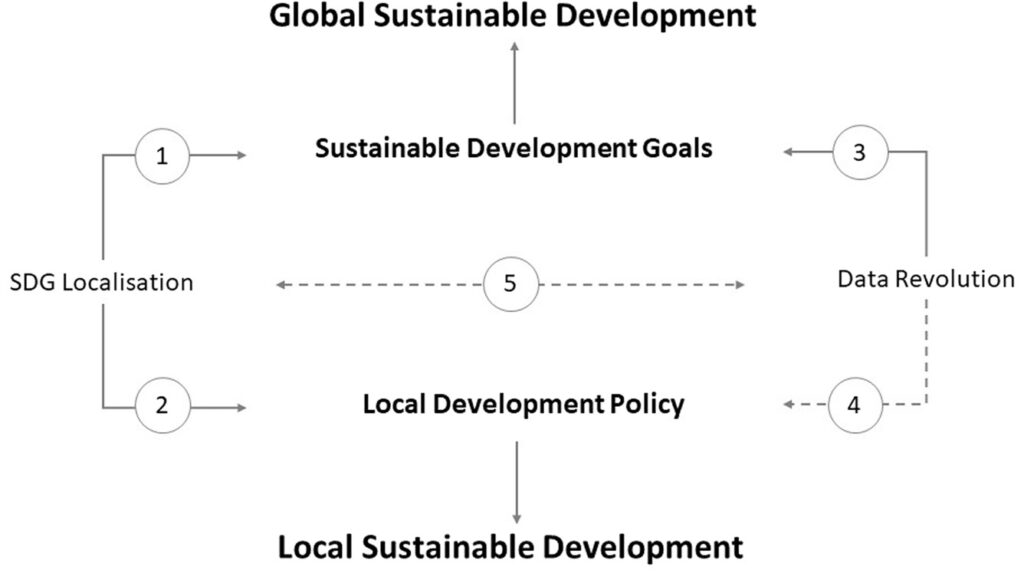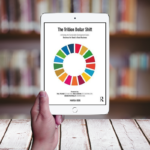Introduction
In their 2022 article, “Lessons from nine urban areas using data to drive local sustainable development,” Garima Jain and Jessica Espey synthesize the results of nine pilot projects supported or commissioned by the United Nations Sustainable Development Solutions Network (SDSN) to highlight the opportunities and challenges of localizing data for tracking SDG progress at the sub-national level in conjunction with the global push to meet the 2030 goals. Their research addresses the key question in this space: “to what extent can data-based approaches improve evidence-based policy at the local level and increase attention towards local and global sustainable development,” (p. 3).
In this post, I summarize the study, highlighting the importance of utilizing the data revolution at the sub-national level to inform policy and goal setting around the SDGs. I specifically focus on the pilot program approach to evaluating areas of weakness for urban areas, including data quality and availability, as the researchers demonstrate opportunities and limitations of the pilot programs to effectively localize the SDGs. I also share strengths and weaknesses the researchers identified from the pilot program approach including data availability and broader applicability of the cases. The conclusion contains my own analysis as well as a few key areas for future research regarding localizing global development initiatives given the data revolution.
Research Approach
- Does more and better data improve the focus of local sustainable development outcomes?
- Does increasing accessibility of data inform and empower people to engage more with local government?
- Are local governments able to harness new technologies from the data revolution to improve the availability of relevant data and information?
- Are local governments able to afford these processes and make them sustainable long-term?
The pilot programs were conducted between 2015 and 2019 across 9 metropolitan areas around the world. The locations were selected for a wide geographic and economic range of cases to help articulate what strengths and challenges arise in varying contexts. Specifically, they studied the approach in three U.S. cities through the United States’ Sustainable Cities Initiative (US-SCI: Baltimore, New York, and San Jose), and six metropolitan regions through the Local Data Action Solutions Initiative (LDA-SI: Patiala, India; Belo Horizonte, Rio de Janeiro, and São Paulo, Brazil; Los Angeles, U.S.; Columbian City Network of 16 cities; Bristol, U.K.; and Aruba).
A comparative analysis of internal and UN narrative reporting on US-SCI and LDA-SI pilot programs served as a basis of study for the researchers to evaluate the progress and obstacles of each case. They applied this framework to contextualize shared challenges and strengths of attempts to localize the SDGs to the sub-national level. The relatively small sample size allowed for an in-depth analysis of how each city, with the help of pilot program implementors, compared the SDGs with current government priorities and planning processes. This included how the cities “back-casted” from past trends and integrated indicators with their newly modified goals to monitor future results.
Findings
A common approach

Relationships between the Sustainable Development Agenda, Data Revolution, and Localization. Source: Jain, G., Espey, J. Lessons from nine urban areas using data to drive local sustainable development. npj Urban Sustain 2, 7 (2022). https://doi.org/10.1038/s42949-022-00050
Another shared method between pilot programs was the use of backcasting to work backwards as a method of planning to meet future goals. In their analysis, Jain and Espey describe the benefits of this new approach for engaging local leadership with SDGs, “the process of aligning the local-level priorities with the framework helped city officials, citizens, and other stakeholders establish a common long-term vision, their desired impact, starting points, and assess their technical capacity for the required data and monitoring,” (p. 4). This introspective process helped the cities engage their community members in intentional goal setting with realistic measurable targets. However, not only did local priorities shift to meet the SDGs, but some cases like Baltimore, created additional indicators they recognized as central to meeting the SDGs in their specific context. The entire process was clearly a step towards encouraging greater data communication between policymakers and the public. The increased ownership and transparency relied on accurate and commonly shared information via books, annual reports, and digital platforms (p. 5).
Obstacles across contexts
The research from Jain and Espey shows a need for available raw data in cities across income levels. Regardless of economic status, urban areas face a shortage of data in an accessible format and commonly available. Information like census data is often limited in how easily it could be disaggregated into sub-city levels to compare with the newly formed indicators. In the program, other available data was restricted by private companies or legal obstacles like data privacy laws (p. 6). This created significant challenges for the pilot programs hoping to address or measure a lack of progress towards the SDGs among their communities and apply data-driven policy to impact change where it was most needed.
When data was available, some areas struggled to manage it effectively. Whether from the census, previous internal tracking mechanisms, shared by civil society organizations or local government institutions, it was often overwhelming to manage. The process of distilling and cleaning massive amounts of data to make it malleable for multiple levels of analysis within the city was often time consuming and required additional resources. Some cities hired a Chief Data Officer to manage this role. Alternatively, some in the Global South faced limited resources and turned to local universities for support (p.7). Other innovative methods for gathering and sorting data across the pilots included web scraping programs, remote-sensing data, spatial mapping systems, and hackathons (p.6). Although additional financial constraints existed for some cities more than others, Jain and Espey emphasized the creative solutions found by all pilot programs to leverage the data they did have access to and organize management systems to apply it directly to their programs.
Strengths and limitations of the pilot programs
The greatest limiting factor they identified was the access to publicly available data. In an age with more data collected than ever before, government institutions were not able to partner with private companies to gather all the necessary information to make informed policy decisions. Secondarily, the data they did have was exceedingly difficult to clean and synthesize for standard use across varying scopes of analysis with the cities. They did offer hopeful suggestions regarding future data collection for these pilot cities moving forward as alternative data collection methods had begun. Although they were described as “limited and inefficient” (p. 8), over a longer period of study they had potential to become better incorporated by private companies and supported by legislation.
Despite these obstacles, the pilot program led to many positive learning opportunities for the participating groups and other cities in similar contexts hoping to improve their efforts to incorporate the SDGs at the sub-national level. Jain and Espey point to cities being encouraged to identify opportunities for innovation and creative thinking to solve financial or technical capacity challenges (p. 8).
I found the diversity of cases created learning outcomes that are widely applicable across different contexts. The pilot programs spanned geographic, economic, and political contexts allowing cities around the world to learn from the many takeaways. Ultimately, the pilot programs helped form a foundation for a more locally led movement for SDGs, and the case-by-case evaluation method of the research contextualized the findings to help readers see a clearer path towards incorporating the data revolution into sub-national urban planning for the SDGs. Future research should investigate how institutions can build a common understanding of the importance of data collaboration for the localization of global development objectives. It is necessary to incorporate local and national leaders, policymakers, and the private sector for stronger bottom-up integration and more data-driven action for long-term sustainable development.




